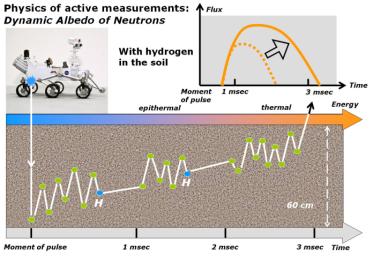
|
Physics of How DAN on Curiosity Checks for Water, Part 2
- Click the image above for a larger view
- Full-Res JPEG (1312 x 902) (200.8 kB)
- Full-Res TIFF (1312 x 902) (3.6 MB)
Caption:
This diagram and the one at PIA16916 illustrate how the Dynamic Albedo of Neutrons (DAN) instrument on NASA's Curiosity Mars rover detects hydrogen in the ground beneath the rover. Detected hydrogen is interpreted as hydroxyl groups or water molecules, such as those bound into the structure of hydrated minerals.
DAN shoots neutrons into the ground and measures the timing and energy levels of neutrons reflected back up. This diagram depicts the case of a neutron that collides with hydrogen atoms before it reaches DAN's detector. Collisions with hydrogen nuclei -- of similar mass to the neutron itself, like two billiard balls -- result in a change in energy level and a change in the time interval between when the neutron is emitted by DAN's neutron generator and when it reaches DAN's detector, compared with neutrons that do not collide with hydrogen, as in the companion diagram.
Background Info:
Russia's Space Research Institute, in Moscow, developed the DAN instrument in close cooperation with the N.L. Dukhov All-Russia Research Institute, Moscow, and the Joint Institute of Nuclear Research, Dubna.
NASA's Jet Propulsion Laboratory, a division of the California Institute of Technology, Pasadena, manages the Mars Science Laboratory Project for NASA's Science Mission Directorate, Washington. JPL designed and built the rover.
More information about Curiosity is online at http://www.nasa.gov/msl and http://mars.jpl.nasa.gov/msl/ .
Cataloging Keywords:
| Name | Value | Additional Values |
|---|---|---|
| Target | Mars | |
| System | ||
| Target Type | Planet | |
| Mission | Mars Science Laboratory (MSL) | |
| Instrument Host | Curiosity Rover | Dynamic Albedo of Neutrons (DAN) |
| Host Type | Rover | |
| Instrument | Dynamic Albedo of Neutrons (DAN) | |
| Detector | ||
| Extra Keywords | Collision, Color, Water | |
| Acquisition Date | ||
| Release Date | 2013-04-08 | |
| Date in Caption | ||
| Image Credit | NASA/JPL-Caltech/Russian Space Research Institute | |
| Source | photojournal.jpl.nasa.gov/catalog/PIA16917 | |
| Identifier | PIA16917 | |
